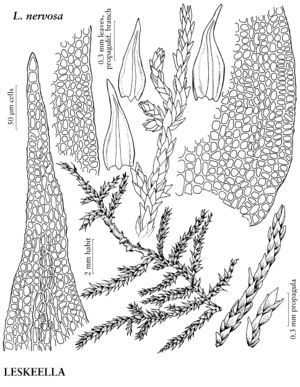Leskeella
Moosfl. Harz., 255. 1903.
| Taxon | Illustrator ⠉ | |
|---|---|---|
 | Leskeella nervosa | Patricia M. Eckel |
Plants small, in thin mats or patches, dark green to blackish. Stems irregularly branched, branches erect, clustered; paraphyllia absent; rhizoids in clusters arising from base of leaves. Stem and branch leaves slightly differentiated. Stem-leaves appressed to erect when dry, erect-spreading when moist, lanceolate, not to weakly plicate on either side of costa; margins recurved proximally, entire to weakly serrulate distally; apex abruptly to gradually acuminate or subulate, hairpoint absent; costa single, strong, nearly reaching apex to percurrent, not 2-fid or sinuate, somewhat obscure distally; alar cells not well differentiated; proximal laminal cells 1–2: 1, walls not or obscurely pitted; medial cells mixed isodiametric, 1–2: 1, smooth, walls firm. Branch leaves more ovatelanceolate, smaller; medial laminal cells usually 1: 1. Specialized asexual reproduction by clustered flagelliform branchlets in axils of distal secondary branch leaves. Sexual condition dioicous; perichaetial leaves pale translucent, longer, apex more acuminate. Seta 1–1.2 cm. Capsule erect to inclined, subcylindric, symmetric; annulus present; operculum conic, short-rostrate; peristome reduced; exostome teeth lanceolate or linear-lanceolate, striolate basally, papillose distally; endostome basal membrane high, segments irregular to filiform, cilia rudimentary to absent. Spores 13–18 µm, finely papillose.
Distribution
North America, Eurasia, s Africa, Atlantic Islands (Iceland)
Discussion
Species 4 (1 in the flora).
Leskeella is found largely in cool-temperate, montane, and boreal-temperate regions. P. S. Wilson and D. H. Norris (1989) provided sound arguments for combining Leskeella and Pseudoleskeella. However, Leskeella is here retained pending a worldwide revision that includes all other species of the genus as well as those of Pseudoleskeella. There appear to be two main groups that do not correspond to the traditional genera, one consisting of species with lanceolate, appressed leaves and a strong costa (L. nervosa, P. arizonae, P. rupestris), and the second of species with ovate-lanceolate catenulate leaves with a short, often 2-fid costa (P. catenulata, P. papillosa, P. tectorum).
Selected References
None.
Lower Taxa
"broad" is not a number.